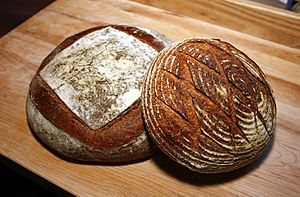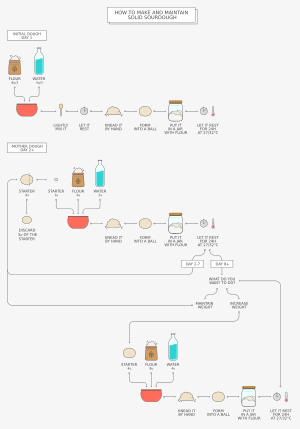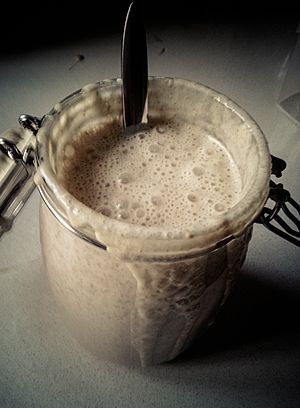Sourdough facts for kids

Two round loaves of sourdough bread
|
|
| Type | Bread |
|---|---|
| Main ingredients | |
Sourdough bread is a special kind of bread. It's made by letting the dough ferment, or bubble up. This happens naturally using tiny living things called lactobacilli and yeast. Instead of using store-bought yeast, sourdough uses these natural helpers. The lactobacilli make a special acid called lactic acid. This acid gives sourdough its slightly sour taste. It also helps the bread stay fresh for longer!
Contents
History of Sourdough
Making bread is a very old skill. People have been doing it for thousands of years! Scientists believe the idea of sourdough started when farming began. This was in a place called the Fertile Crescent. One of the oldest sourdough breads found is from Switzerland. It dates back to about 3700 BCE. For most of history, sourdough was the main way to make bread rise. Using baker's yeast, like we often do today, is much newer. It's only been around for about 150 years.
An ancient writer named Pliny the Elder wrote about sourdough. He explained how people used dough saved from the day before. He said it was natural for the sourness to make the dough bubble up.
Sourdough was the main way to make bread rise until the Middle Ages in Europe. Later, people started using "barm." This was a foamy part left over from making beer. Even later, special yeast grown just for baking became popular.
In northern Europe, bread made from 100% rye flour is common. This bread usually uses sourdough to rise. Regular baker's yeast doesn't work well for rye bread. This is because rye flour doesn't have much gluten. Gluten is what gives wheat bread its stretchy structure. Rye bread's structure comes from its starch and other carbohydrates. But rye starch can break down too much when heated. Sourdough helps by making the dough more acidic. This stops the starch from breaking down too much. It lets the bread set properly. In southern Europe, sourdough was once used for breads like panettone. But now, faster-growing baker's yeast is often used instead. Sometimes, they let the dough rest longer. This allows some bacterial activity to build flavor.
In countries like the U.S. and U.K., wheat breads are more common. Sourdough is not the usual way to make bread rise anymore. It was slowly replaced by barm. Then, after scientists like Louis Pasteur learned about germs, cultured yeasts became popular. Sourdough bread became less common in big bakeries in the 1900s. But now, many special bakeries are bringing it back!
Some breads that don't use sourdough might add something called "bread improver." This is a mix made to help the dough. It makes up for not having the natural yeast and bacteria.
How Sourdough is Made
The Starter
Making sourdough starts with something called a "starter." You might also hear it called a "leaven" or "mother." It's a fermented mix of flour and water. This mix has a group of tiny living things inside. These include wild yeast and lactobacilli. The starter's job is to make the bread rise well. It also helps create the bread's special flavor. There are a few different kinds of starters.
Flour naturally has different kinds of yeast and bacteria. When flour mixes with water, an enzyme breaks down the starch into sugars. The yeast in sourdough can use these sugars. This mix then grows into a stable group of bacteria. They will use fermentation. The yeast will also make carbon dioxide gas. This gas is what makes the dough rise and get bubbly.
It takes longer for sourdough to rise compared to bread made with baker's yeast. This is because the yeast in sourdough is not as strong. But, with the help of the lactic acid bacteria, some sourdough yeasts can make a lot of gas. The sour conditions in sourdough can also make the gluten weaker. This might lead to a slightly denser bread.
Feeding the Starter
As the starter ferments, you need to add more flour and water to it. This is called "refreshing" or "feeding" the starter. You might do this over several days. As long as you feed your starter regularly, it will stay active.
The amount of old starter you mix with new flour and water is important. This is called the refreshment ratio. A higher ratio means the tiny living things in the sourdough stay more stable. For example, in San Francisco sourdough, the ratio is about 40% of the total weight. A high ratio helps keep the dough's sourness lower. If it gets too sour (below pH 4.0), it can stop the lactobacilli from working well.
A starter made from scratch with salted wheat-rye dough takes about 54 hours. This is at 27 degrees Celsius (80 degrees Fahrenheit). It will then settle at a pH between 4.4 and 4.6. Salt can stop some bacteria from growing.
A drier and cooler starter will have less bacteria activity. It will have more yeast growth. This makes more acetic acid, which gives a sharper sour taste. A wetter and warmer starter will have more bacteria. It will have less yeast growth. This makes more lactic acid, which is a milder sourness. The yeasts mostly make CO2 gas and alcohol. Lots of lactic acid is good for rye breads. More acetic acid is often wanted in wheat breads. So, a dry, cool starter makes a more sour loaf.
How Often to Feed
For a stable starter with the main bacteria L. sanfranciscensis, keep it between 25 and 30 degrees Celsius (77-86 degrees Fahrenheit). You should feed it every 24 hours for about two weeks. If you wait longer than three days between feedings, the dough can get too sour. This might change the balance of the tiny living things.
You can feed the starter more often to make it produce gas faster. This is called "acceleration." This can change the balance of yeasts to lactobacilli. If you don't feed it more often, you might need less starter in your final dough. This helps the bread rise well.
There are also faster ways to make a starter. Some use special commercial sourdough starters. These can be dried traditional starters. Or they can be made from specific tiny living things grown in labs. These are mixed to create a starter with known amounts of microorganisms.
Baking the Bread
You need to feed your starter 4 to 12 hours before you bake. Mix flour and water into the starter. This makes an "active leaven." It should grow in size and be bubbly. It's ready when a small piece floats in water. Then, mix the leaven with more flour and water. This makes the final dough. The amount of starter is usually 13% to 25% of the total flour weight. But recipes can be different.
Next, you shape the dough into loaves. You let them rise. Then, you bake them! There are also "no knead" methods for sourdough bread. Sourdough bread takes a long time to rise. So, many bakers put their loaves in the fridge before baking. This is called "retardation." It slows down the rising process. This also helps the bread get a richer flavor.
Most sourdough starters take longer to rise than breads made with baker's yeast. So, sourdough is usually not good for bread machines. However, you can let your sourdough rise for many hours. Then, you can put it in the bread machine just for baking. This skips the machine's kneading part. This can be handy for one loaf. But, you won't get the special crust of oven-baked sourdough. That usually needs a baking stone in the oven and steam. Also, bread machines make loaves in a specific shape. This isn't always ideal for the best crust.
Images for kids






